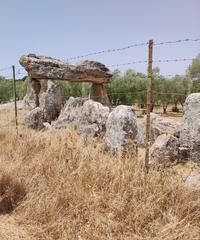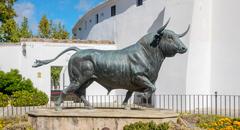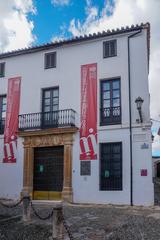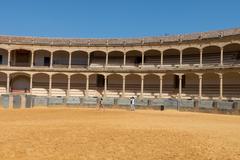Abrigo del Puerto del Viento: Visiting Hours, Tickets, and Comprehensive Guide to Ronda Historical Sites
Date: 14/06/2025
Introduction
Nestled in the rugged landscapes of Andalusia’s Sierra de las Nieves and Serranía de Ronda, Abrigo del Puerto del Viento—meaning “Shelter of the Wind Pass”—is a unique site where natural beauty meets deep historical and cultural significance. Perched at elevations between 1,071 and 1,190 meters, this mountain pass offers panoramic vistas and is key to understanding the human history of the Ronda region. Its strategic location has made it a crossroads for travelers, shepherds, and civilizations for millennia, evidenced by prehistoric cave art, Roman roads, and medieval fortifications (Climbfinder; Wikiloc).
Visitors are drawn not only by the natural allure and biodiversity of the UNESCO-listed Sierra de las Nieves Biosphere Reserve but also by the site’s integration into Ronda’s medieval Albacara walls and its easy connection to iconic attractions like Puente Nuevo, Acinipo Roman ruins, the Plaza de Toros, Baños Árabes, and Palacio de Mondragón (Andalucía Cicloturismo; Spanish Plains).
This guide provides thorough information on the historical context, visitor logistics, accessibility, travel tips, and recommendations for nearby attractions—ensuring a rewarding experience for history enthusiasts, nature lovers, and cultural explorers alike.
Historical and Cultural Significance
Historical Context
Abrigo del Puerto del Viento is part of Ronda’s medieval defensive system, specifically within the Albacara sector of the city’s walls. The fortifications, developed extensively during the Islamic rule and further modified post-Reconquista, protected agricultural assets and controlled passage through the mountainous terrain. The region’s roots reach back to the Paleolithic era, as reflected by nearby sites like Cueva de la Pileta (ayuntamientoronda.es).
Architectural and Defensive Role
Unlike ceremonial city gates, Puerto del Viento was designed for practicality—enabling the movement of goods and livestock and, in times of unrest, facilitating evacuation. Robust masonry and strategic placement leveraged the natural topography, while the surrounding walls defended essential economic resources (ayuntamientoronda.es).
Symbolism and Multicultural Heritage
The gate and fortifications symbolize Ronda’s resilience and its layered history, blending Roman, Islamic, and Christian influences. Even as the structures were adapted for new uses after the Reconquista, their original forms remain, offering a tangible link to past societies and their lifestyles.
Integration in Ronda’s Urban Landscape
Designated a Bien de Interés Cultural since 1966, Puerto del Viento is within walking distance of Ronda’s most prominent historical sites. Its surroundings feature narrow streets, traditional homes, and preserved defensive walls, making it an ideal starting point for tours exploring Ronda’s medieval fabric.
Broader Historical Narrative
The significance of the pass is underscored by its context within a landscape shaped by prehistoric, Roman, Islamic, and Christian influences. The nearby Roman city of Acinipo and Paleolithic caves highlight the region’s longstanding importance as a crossroads of cultures (ayuntamientoronda.es).
Visiting Abrigo del Puerto del Viento
Location and Access
Situated on the A-366 road northeast of Ronda, the pass marks a natural corridor between the Ronda plateau and the Turón river basin. It is about 11 km from Ronda’s city center and is accessible by car, bicycle, or on foot. The site features a modest rock shelter typical of the region’s limestone geology (Climbfinder; Komoot).
Directions
- By Car: Follow the A-366 from Ronda toward El Burgo; parking is available near the summit.
- By Bike/On Foot: Popular cycling and hiking routes ascend from Ronda, with the climb offering moderate difficulty and impressive scenery (Komoot).
- Public Transport: Not available directly to the pass; taxi or private transfer required from Ronda.
Opening Hours and Admission
- Access: Open 24/7 all year; no entrance fee.
- Facilities: No amenities at the pass. The nearest services are in Ronda or El Burgo (Wikiloc).
Site Features
- Natural Shelter: A shallow limestone cave providing protection from the wind.
- Landscape: Dramatic karst formations, panoramic views, and access to hiking and cycling trails.
- Signage: Limited; bring maps or GPS.
Climate and Safety
- Weather: Exposed to strong winds and sudden changes; cool even in summer, with possible snow in winter.
- Terrain: Rocky and uneven—sturdy footwear essential.
- Safety: Mobile coverage is patchy; carry water, sun protection, and dress in layers.
Accessibility
- Mobility: Not suitable for wheelchairs; challenging terrain for those with limited mobility.
- Children: Recommended for older children with hiking experience.
Exploring the Area: Activities and Attractions
Hiking and Nature
The pass serves as a gateway to:
- Cueva de los Covarones and Fuente Alberquilla: A scenic circular hiking route with caves and springs (Wikiloc).
- Cancho La Pepa: A peak with historical remnants on its slopes.
- Cañada Real de Málaga: An ancient drovers’ path still in use.
The area is part of the Sierra de las Nieves National Park, home to rare flora like the Spanish fir and wildlife such as ibex and raptors.
Cycling
Cyclists enjoy the climb to the pass, with gradients of 3–6% and outstanding views (Komoot).
Photography and Wildlife
With sweeping vistas of the Serranía de Ronda and Sierra de Grazalema, the pass is a favorite for landscape and wildlife photography—especially at sunrise and sunset (Climbfinder).
Nearby Historical and Cultural Sites
- Puente Nuevo & El Tajo Gorge: Iconic bridge spanning a dramatic canyon (Spanish Plains; Earth Trekkers).
- Plaza de Toros: One of Spain’s oldest bullrings, with a museum (Explored by Marta).
- Baños Árabes: Well-preserved Islamic baths (Spanish Plains).
- Palacio de Mondragón: Museum tracing Ronda’s history (Spanish Plains).
- Acinipo Roman Ruins: Roman theater and Bronze Age settlements nearby (Zigzag On Earth).
- Setenil de las Bodegas: Unique cave village (Zigzag On Earth).
Travel Tips and Practical Information
- Best Seasons: Spring and autumn for mild weather and wildflowers.
- What to Bring: Sturdy boots, layered clothing, sun and wind protection, water, snacks, and navigation aids.
- Guided Tours: Available from Ronda for deeper historical and ecological context (Wanderlust Photos Blog).
- Responsible Tourism: Respect wildlife, stay on marked trails, and carry out all litter.
Emergency Info
- Nearest Hospital: In Ronda.
- Emergency Number: 112 (Spain).
Frequently Asked Questions (FAQs)
Q: What are the visiting hours for Abrigo del Puerto del Viento?
A: Open 24/7 all year round; no admission fee.
Q: How do I get there?
A: By car or bicycle from Ronda via the A-366; no direct public transport.
Q: Is it suitable for children or those with mobility issues?
A: Best for older children with hiking experience; terrain is rugged and not wheelchair accessible.
Q: Are there facilities at the site?
A: No; nearest amenities are in Ronda or El Burgo.
Q: What else can I see nearby?
A: Ronda’s historical sites, Acinipo ruins, Setenil de las Bodegas, and hiking trails in the Sierra de las Nieves.
Enhance Your Visit
Leverage digital resources like the Audiala app for offline maps, guided tours, and real-time visitor updates. For further planning, consult official tourism platforms and local visitor centers.
Summary
Abrigo del Puerto del Viento stands as a testament to Ronda’s enduring legacy—a site where natural grandeur and centuries of history converge. Its open access, spectacular setting, and proximity to renowned Ronda landmarks make it an essential stop for anyone exploring southern Spain. Plan your visit during spring or autumn for the best experience, and remember to explore responsibly to help preserve this cultural and natural treasure.
References
- This is a sample text. (ayuntamientoronda.es)
- This is a sample text. (Climbfinder)
- This is a sample text. (Andalucía Cicloturismo)
- This is a sample text. (Wikiloc)
- This is a sample text. (Komoot)
- This is a sample text. (Spanish Plains)
- This is a sample text. (Zigzag On Earth)
- This is a sample text. (Explored by Marta)
- This is a sample text. (Earth Trekkers)
- This is a sample text. (Nomads Travel Guide)
- This is a sample text. (Vamos Spanish)
- This is a sample text. (The Crazy Tourist)
- This is a sample text. (Tania Travel Stories)
- This is a sample text. (Wanderlust Photos Blog)
- This is a sample text. (Mapcarta)
- This is a sample text. (Prehistoria del Sur)



